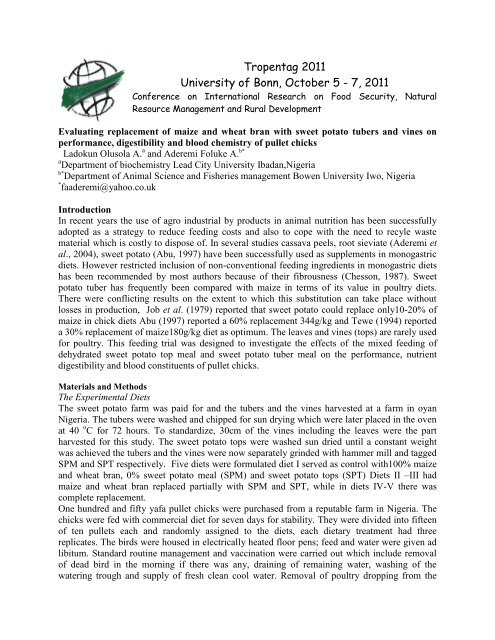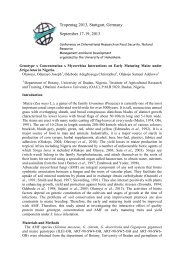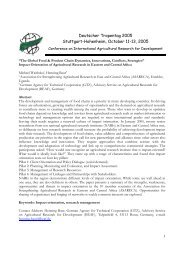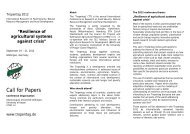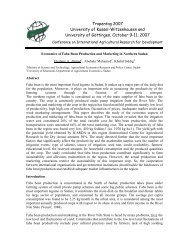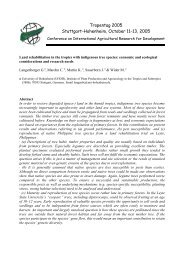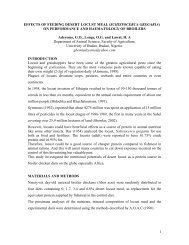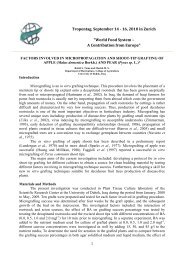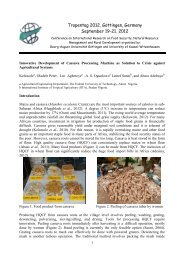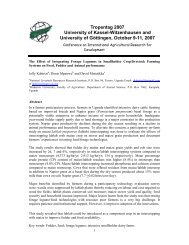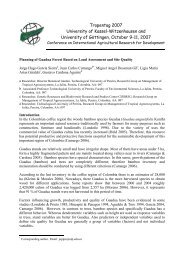Tropentag 2011 University of Bonn, October 5 - 7, 2011
Tropentag 2011 University of Bonn, October 5 - 7, 2011
Tropentag 2011 University of Bonn, October 5 - 7, 2011
You also want an ePaper? Increase the reach of your titles
YUMPU automatically turns print PDFs into web optimized ePapers that Google loves.
<strong>Tropentag</strong> <strong>2011</strong><br />
<strong>University</strong> <strong>of</strong> <strong>Bonn</strong>, <strong>October</strong> 5 - 7, <strong>2011</strong><br />
Conference on International Research on Food Security, Natural<br />
Resource Management and Rural Development<br />
Evaluating replacement <strong>of</strong> maize and wheat bran with sweet potato tubers and vines on<br />
performance, digestibility and blood chemistry <strong>of</strong> pullet chicks<br />
Ladokun Olusola A. a and Aderemi Foluke A. b*<br />
a Department <strong>of</strong> biochemistry Lead City <strong>University</strong> Ibadan,Nigeria<br />
b* Department <strong>of</strong> Animal Science and Fisheries management Bowen <strong>University</strong> Iwo, Nigeria<br />
* faaderemi@yahoo.co.uk<br />
Introduction<br />
In recent years the use <strong>of</strong> agro industrial by products in animal nutrition has been successfully<br />
adopted as a strategy to reduce feeding costs and also to cope with the need to recyle waste<br />
material which is costly to dispose <strong>of</strong>. In several studies cassava peels, root sieviate (Aderemi et<br />
al., 2004), sweet potato (Abu, 1997) have been successfully used as supplements in monogastric<br />
diets. However restricted inclusion <strong>of</strong> non-conventional feeding ingredients in monogastric diets<br />
has been recommended by most authors because <strong>of</strong> their fibrousness (Chesson, 1987). Sweet<br />
potato tuber has frequently been compared with maize in terms <strong>of</strong> its value in poultry diets.<br />
There were conflicting results on the extent to which this substitution can take place without<br />
losses in production, Job et al. (1979) reported that sweet potato could replace only10-20% <strong>of</strong><br />
maize in chick diets Abu (1997) reported a 60% replacement 344g/kg and Tewe (1994) reported<br />
a 30% replacement <strong>of</strong> maize180g/kg diet as optimum. The leaves and vines (tops) are rarely used<br />
for poultry. This feeding trial was designed to investigate the effects <strong>of</strong> the mixed feeding <strong>of</strong><br />
dehydrated sweet potato top meal and sweet potato tuber meal on the performance, nutrient<br />
digestibility and blood constituents <strong>of</strong> pullet chicks.<br />
Materials and Methods<br />
The Experimental Diets<br />
The sweet potato farm was paid for and the tubers and the vines harvested at a farm in oyan<br />
Nigeria. The tubers were washed and chipped for sun drying which were later placed in the oven<br />
at 40 o C for 72 hours. To standardize, 30cm <strong>of</strong> the vines including the leaves were the part<br />
harvested for this study. The sweet potato tops were washed sun dried until a constant weight<br />
was achieved the tubers and the vines were now separately grinded with hammer mill and tagged<br />
SPM and SPT respectively. Five diets were formulated diet I served as control with100% maize<br />
and wheat bran, 0% sweet potato meal (SPM) and sweet potato tops (SPT) Diets II –III had<br />
maize and wheat bran replaced partially with SPM and SPT, while in diets IV-V there was<br />
complete replacement.<br />
One hundred and fifty yafa pullet chicks were purchased from a reputable farm in Nigeria. The<br />
chicks were fed with commercial diet for seven days for stability. They were divided into fifteen<br />
<strong>of</strong> ten pullets each and randomly assigned to the diets, each dietary treatment had three<br />
replicates. The birds were housed in electrically heated floor pens; feed and water were given ad<br />
libitum. Standard routine management and vaccination were carried out which include removal<br />
<strong>of</strong> dead bird in the morning if there was any, draining <strong>of</strong> remaining water, washing <strong>of</strong> the<br />
watering trough and supply <strong>of</strong> fresh clean cool water. Removal <strong>of</strong> poultry dropping from the
emaining feeds in the feeders and addition <strong>of</strong> fresh feed on daily basis. Records <strong>of</strong> feed intake,<br />
weight gain and feed efficiency were determined weekly on all replicates which lasted for ten<br />
weeks.<br />
Metabolic Trial<br />
Two 56 day old pullet chicks <strong>of</strong> similar weights from each dietary treatment were separately<br />
housed in metabolic cages. Equal quantity <strong>of</strong> 75 g feed was served at 8.00 am daily to each bird.<br />
The birds were routinely managed dropping were collected and weighed daily separated from<br />
feed and other extraneous materials then oven dried at 85 o C for 48 hours. Weights <strong>of</strong> wet and<br />
oven dried droppings were recorded to calculate the dry matter. The dried samples were kept for<br />
chemical analysis.<br />
Blood Analysis<br />
At four weeks <strong>of</strong> age, two birds per replicate were randomly selected and bled by puncturing the<br />
jugular vein blood was collected in carefully labeled specimen bottles for estimation <strong>of</strong> serum<br />
metabolites. The blood was allowed to clot and the serum decanted after centrifugation. Serum<br />
total proteins (albumin and globulins) were determined according to the method <strong>of</strong><br />
Doumas(1975). The glucose fraction was determined using the method <strong>of</strong> Bonder and Mead<br />
(1974, total cholesterol according to Allain et al. (1974). Urea was estimated by the<br />
diacetylmonoxine method described by Fawett and Scott (1960) and modified by Kaplan and<br />
Szabo (1979). Aspartste amino transferase (SAST) and Alanine amino transferase (SALT) were<br />
analysed using a method described by Auckers (1970).<br />
Chemical analysis<br />
The proximate composition <strong>of</strong> the experimental diets and droppings were estimated by the<br />
methods <strong>of</strong> AOAC (2000) while the gross energy values <strong>of</strong> the diets were determined using the<br />
bomb calorimeter.<br />
Statistical Analysis<br />
All the data generated in this study were analyzed according to the procedure <strong>of</strong> the Statistical<br />
Analysis System (SAS 2001).<br />
Results and Discussion<br />
There were five diets each with three replicates <strong>of</strong> ten chicks. Diet I served as control with100%<br />
maize and wheat bran, 0% sweet potato meal (SPM) and sweet potato tops (SPT) Diets II –III<br />
had maize and wheat bran replaced partially with SPM and SPT, while in diets IV-V there was<br />
complete replacement Table 1.
Table 1: Gross composition <strong>of</strong> experimental diets<br />
Ingredients I II III IV V<br />
Maize:SPM 100:0 50:50 50:50 0:100 0:100<br />
Wheatbran:SPT 100:0 50:50 0:100 50:50 0:100<br />
Maize 50.0 25.0 25.0 - -<br />
SPM - 25.0 25.0 50.0 50.0<br />
Wheat bran 18.40 9.2 - 9.2 -<br />
SPT - 0.2 18.4 9.2 18.4<br />
Groundnut cake 6.0 6.0 6.0 6.0 6.0<br />
Soybean meal 19.0 19.0 19.0 19.0 19.0<br />
Fish meal 3.0 3.0 3.0 3.0 3.0<br />
Bone meal 2.0 2.0 2.0 2.0 2.0<br />
Oyster meal 1.0 1.0 1.0 1.0 1.0<br />
Premix* .25 .25 .25 .25 .25<br />
Salt .25 .25 .25 .25 .25<br />
Methionine .10 .10 .10 .10 .10<br />
Calculated<br />
analysis(%)<br />
Crude protein 20.76 20.13 20.32 19.84 19.98<br />
Crude fibre 4.13 5.88 7.12 6.04 6.98<br />
ME kcal/kg 2818.28 3045.94 3137.25 3175.43 3244.47<br />
*To provide the following per kg diet vitamin A 10,000iu vit D3 1500iu vit E 715mg,vit K2mg rib<strong>of</strong>lavin 3mg pantothenic acid 6mg, niacin 15mg<br />
choline 5mg,vit B12 0.08mg, folic acid 4mg,Mn 8mg Zn0.5mg 11.0mg Co12mg;Cu10mg Fe 20mg.<br />
Results show that daily feed intake ranged from 28.02g (100%SPM, 50%SPT) to 42.65g for<br />
chicks on the control Table 2.<br />
Table 2: Performance characteristics <strong>of</strong> pullet chicks fed partial and completely replaced maize and wheat bran diets<br />
Diets I II III IV V SEM<br />
Maize:SPM 100:0 50:50 50:50 0:100 0:100<br />
Wheatbran:SPT 100:0 50:50 0:100 50:50 0:100<br />
Parameters<br />
Initial body<br />
55.52 55.45 55.53 55.56 55.47 0.04<br />
weight(g)<br />
Final body wt(g) 492.10 a 426.30 b 369.6 c 362.6 c 319.06 d 0.87<br />
weightgain<br />
(g/bird/day)<br />
7.03 a 6.09 b 5.28 c 5.18 c 5.38 c 0.07<br />
feedintake<br />
(g/day)<br />
42.65 a 34.88 b 30.78 c 30.56 c 28.02 d 0.56<br />
Feed:gain ratio 11.54 c 12.22 b 12.01 b 11.87 c 13.44 a 0.14<br />
Mortality(%) 0 b 0 b 10 a 10 a 10 a 0.67<br />
abc Means with the same superscript along a row are not significantly different (P>0.05)
Feed conversion efficiency shows that those on control diets had the best value. This suggest<br />
improper utilization <strong>of</strong> the test ingredients this agrees with Olugbemi et al(2010).Digestibility<br />
measures the ratio <strong>of</strong> the nutrient retained to intake expressed in percentage. The digestibility <strong>of</strong><br />
dry matter values <strong>of</strong> chicks on the control appeared better than the sweet potato diets Table3.<br />
Table 3: Apparent nutrient digestibility <strong>of</strong> pullet chicks fed partial and completely replaced maize and<br />
wheat bran diets<br />
Diets I II III IV V SEM<br />
Maize:SPM 100:0 50:50 50:50 0:100 0:100<br />
Wheatbran:SPT 100:0 50:50 50:50 50:50 0:100<br />
Parameters<br />
Dry matter 71.00 a 70.09 b 70.44 b 65.50 d 61.35 c 0.93<br />
Crude protein 72.50 a 73.03 a 73.58 a 69.92 b 71.46 b 0.37<br />
Ether extract 80.34 a 78.78 b 78.41 b 78.02 b 77.95 c 0.28<br />
NDF 54.40 c 69.89 a 70.02 a 60.15 b 69.92 a 0.17<br />
ADF 20.87 21.62 23,10 22.05 22.68 0.22<br />
abc Means with the same superscript along a row are not significantly different (P>0.05)<br />
The decrease in dry matter digestibility <strong>of</strong> the sweet potato based diet is consistent with the<br />
findings <strong>of</strong> Abdel-Samie et al (1983). Perhaps the different chemical composition <strong>of</strong> maize/SPM<br />
on one hand and wheat bran/SPT on the other hand was responsible for this and this is similar to<br />
the findings <strong>of</strong> Therdchai and Mikled (2001).The haematological parameters observed the<br />
plasma protein (PP) mean cell volume (MCV) and MCHC were significantly affected (P0.05)<br />
The chicks fed control and partially replaced diets had similar haematological values and these<br />
were higher compared to other diets. The total protein, albumin, cholesterol, urea, serum alanine<br />
transaminase values <strong>of</strong> all the chicks were within standard range when compared with reports <strong>of</strong><br />
Mitruska and Rawnsley (1977).This implied no impairment to the liver <strong>of</strong> the fed chickens. The<br />
glucose value increased as the level <strong>of</strong> inclusion <strong>of</strong> SPM and SPT increased this perhaps suggest
the unavailability <strong>of</strong> this for the animal use and possibly inhibition to glycolysis by the diets. The<br />
mortality recorded during the feeding trial however cut across the diets and could not be linked<br />
to dietary treatment.<br />
Conclusions and Outlook<br />
Conclusively partial replacement <strong>of</strong> maize and wheat bran with SPM and SPT supported growth<br />
without abnormality in blood pr<strong>of</strong>ile <strong>of</strong> the experimental birds. Thus partial replacement <strong>of</strong><br />
maize with SPM and Wheat bran with SPT would be a valuable feeding strategy.<br />
References<br />
Abdel-Samie, R.E., Ranweera K.N.P. and Nano W.E. (1983). The influence <strong>of</strong> fibre content and<br />
physical texture <strong>of</strong> the diet on the performance <strong>of</strong> broilers in the tropics. British poultry Science<br />
Journal 24:283-290.<br />
Abu O.A. (1997) Biochemical characterization and utilization <strong>of</strong> processed sweet potato (Ipomea<br />
batatas) for rabbit feeding. Ph.D. thesis Department <strong>of</strong> Animal Science.<strong>University</strong> <strong>of</strong> Ibadan,<br />
Ibadan Nigeria.<br />
Aderemi, F.A. Ladokun O.A. Tewe O.O. (2004). Study on haematology and serum<br />
biochemistry<strong>of</strong> layers fed biodegraded cassava root sieviate. Bowen Journal <strong>of</strong> Agric. 1 pp. 78 –<br />
83.<br />
Allain C.A. Poon L.S., Chang C.S.G., Richmond W. and Fu P.C. (1974) Enzymatic<br />
determination <strong>of</strong> total serum cholesterol.Clinical chemistry 20:470-475.<br />
A.O.A.C. (2000) Officail methods <strong>of</strong> analysis Association <strong>of</strong> <strong>of</strong>ficial analytical chemists<br />
Wasghinton D.C.<br />
Auckers G.K. (1970) Analytical gel chromatography <strong>of</strong> proteins Advance protein chemistry <strong>of</strong><br />
Agricultural Food chemistry 32: (3) 469-473.<br />
Bonder R.J. L. and Mead D.C. (1974) Evaluation <strong>of</strong> Glucose -6 phosphate dehydrogenase from<br />
lecuonostoc mesteteroides in the hexokinase method for determining glucose in serum. Clinical<br />
Chemistry, 20:586-590.<br />
Chesson A. (1987) Supplementary enzymes to improve utilization <strong>of</strong> pigs and poultry diets.<br />
Recent Advances in Animal Nutrition. Butterworth London 71-89.<br />
Doumas B.T. (1975) Standards for total protein assay a collaborative study. Clinical Chemistry,<br />
21: 1159-1166.<br />
Fawett J.K. and Scott J.E. (1960) A rapid and precise method for determination <strong>of</strong> urea Journal<br />
Clinical pathology 13: 156-159.<br />
Job T.A., Oluyemi J.A. and Emtonu S. (1979) Replacing maize with sweet potato in diets for<br />
chicks. British Poultry Journal 20: 515-519.
Kaplan A. and Szabo L.L. (1979) Clinical chemistry :interpretation and technique. Henry<br />
Kampton pubishers, London pp 109-110.<br />
Mitruska B.M. and Rawnsley H.M. (1977) In: Clinical biochemical and haematological<br />
reference value in normal experimental animals Masson publishing USA, Inc.<br />
Olugbemi T.S., Mutayoba S.K. and Lekule F.P. (2010) Evaluation <strong>of</strong> moringa oleifera leaf meal<br />
inclusion in cassava chip based diets fed to laying birds. Livestock Research for Rural<br />
Development 22 (6): 1-7.<br />
SAS Institute (2001) SAS/STAT guide for personal computers, version and edition (Cary North<br />
Carolina SAS Institute).<br />
Tewe O.O. (1994) Biochemistry and Utilization <strong>of</strong> Sweet potato (Ipomea batata) for Animal<br />
feed. Implications for food security for Africa in :Product development for Root and Tuber<br />
Crops, Vol III –Africa (Lima, Peru/ Ibadan.Nigeria.International Potato centre /International<br />
Institute <strong>of</strong> Tropical Agriculture.<br />
Therdchai V. and Mikled C. (2001) Site and extent <strong>of</strong> cassava starch digestion in Ruminants.<br />
International Workshop on current Research and Development on Use <strong>of</strong> Cassava as Animal<br />
Feed. Khon Kaen <strong>University</strong>, Thailand, July 23-24 2001. Retrieved 15 th April 2008 from<br />
http:www.mekarn.org/procKK/choc.htm


